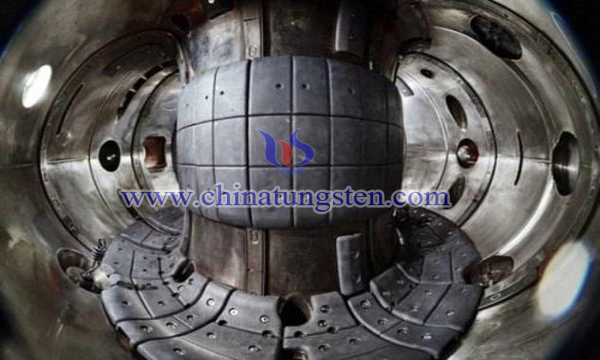ITER Plasma Tungsten Coating
- Details
- Category: Tungsten Information
- Published on Thursday, 08 March 2018 17:47
Tungsten has high melting point, excellent thermal conductivity, low sputtering yield and high sputtering threshold, low vapor pressure and low tritium retention property. It is considered as the most promising divertor and first wall plasma facing material for fusion experimental device and fusion reactor in the future.

The preparation technology of tungsten coating mainly includes plasma spraying (PS), physical vapor deposition (physical vapor deposition), chemical vapor deposition (CVD) and so on. Among them, PS technology is simple, high efficiency, low cost, and it can be repaired in situ and is not limited by workpiece shape. But the purity of PS tungsten coating is low, the density is only 90% of sintered pure tungsten, and the thermal conductivity is 25-60% lower than that of pure tungsten. In addition, the tensile strength of the PS tungsten coating is only 15% of the sintered tungsten, the bonding strength of the coating and the substrate is low, and the preparation of the large area is difficult.
Tungsten coating prepared by CVD in high purity, which can reach above 99.99%, coating density, thermal conductivity and strength and forging pure tungsten equivalent; CVD tungsten has columnar crystal structure makes it has excellent resistance to high heat load performance, the cracks appear only in the columnar crystal along the direction; at the same time, CVD also can in the deposition coating on the surface of substrate bending, capable of producing complex shaped parts coating. Therefore, CVD tungsten coating has a very good application prospect in the manufacture of plasma components.
Chromium zirconium copper alloy is a deposit hardened copper alloy. It has good thermal conductivity and mechanical properties. It is widely selected as the heat sink and structural material of the first wall and divertor by the International Thermonuclear Experimental Reactor (ITER) and other fusion devices. Copper is often used as an intermediate layer to alleviate the interfacial stress caused by the difference of thermal expansion coefficient between W and Cr Zr Cu alloy.
The intermediate layer is prepared by physical vapor deposition. Chromium zirconium copper alloy substrate can be complex geometric shape, which is not limited to plate structure, and has wide adaptability compared with hot isostatic pressing diffusion welding, hot pressing diffusion welding, laminated rolling and explosive compounding technology. After that, the tungsten coating was prepared by direct chemical vapor deposition, with good interfacial bonding force, high density and no defects.
- Tungsten Manufacturer & Supplier, Chinatungsten Online: www.chinatungsten.com
- Tungsten News & Prices of China Tungsten Industry Association: www.ctia.com.cn
- Molybdenum News & Price: news.molybdenum.com.cn
- Tel.: 86 592 5129696; Fax: 86 592 5129797; Email: sales@chinatungsten.com



 sales@chinatungsten.com
sales@chinatungsten.com